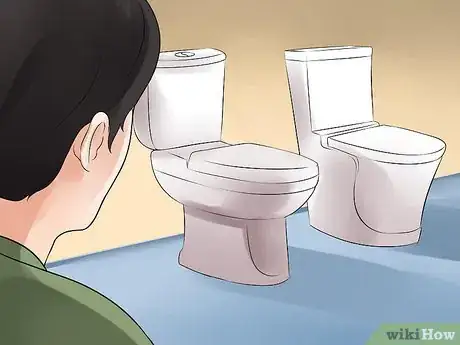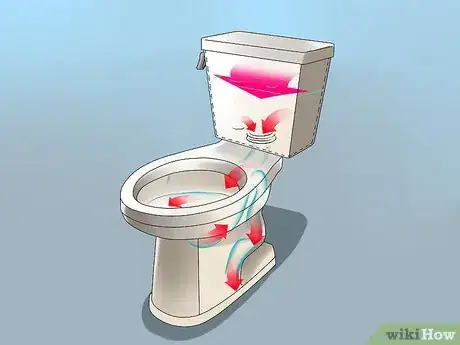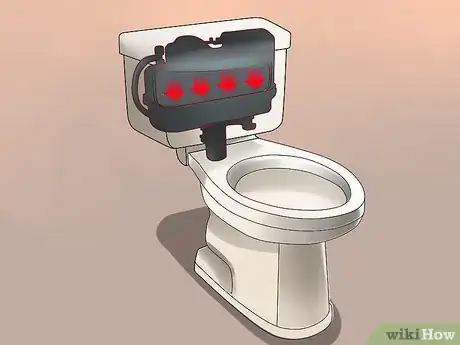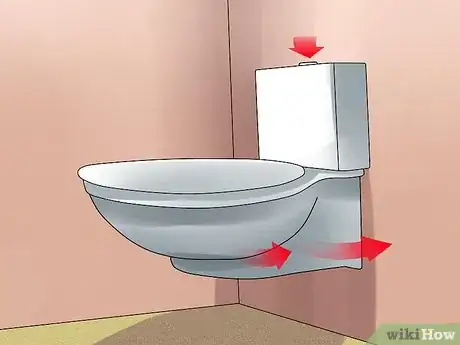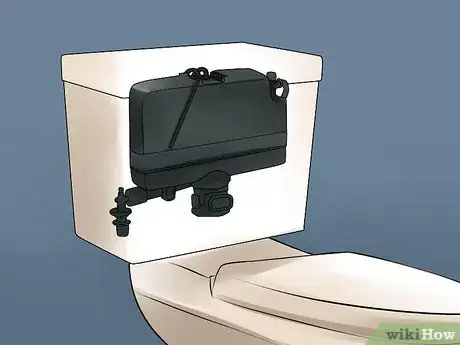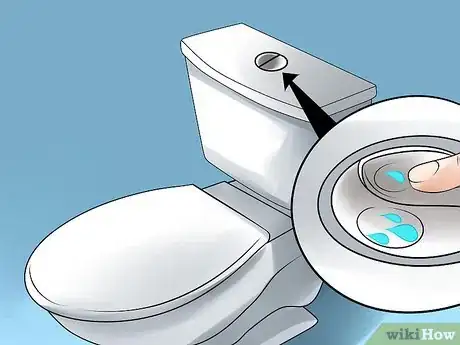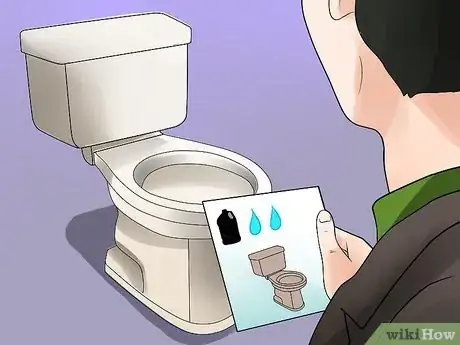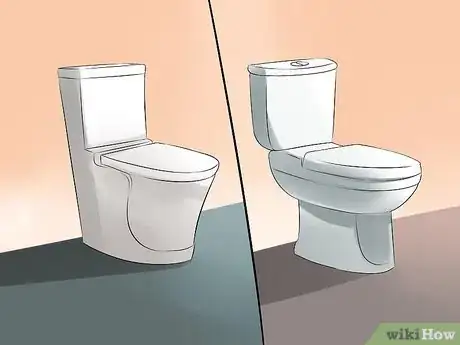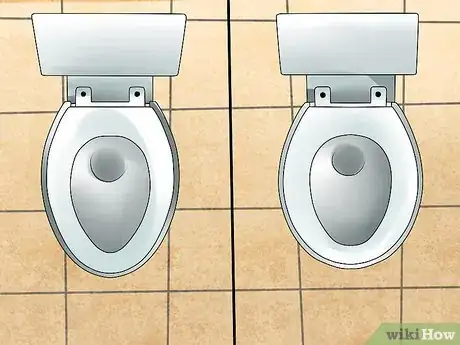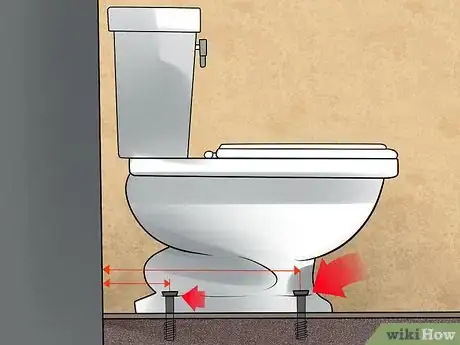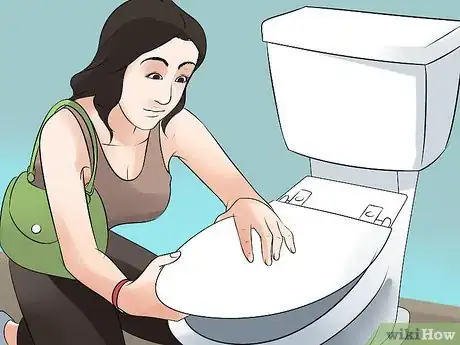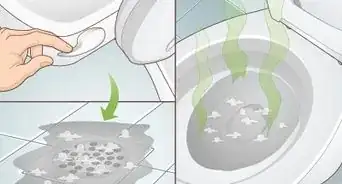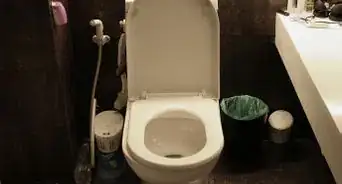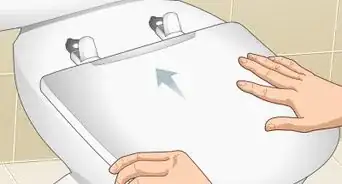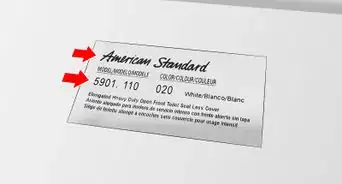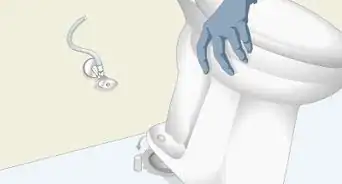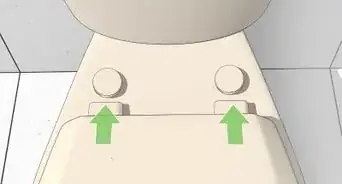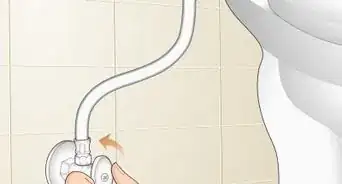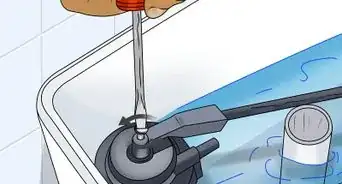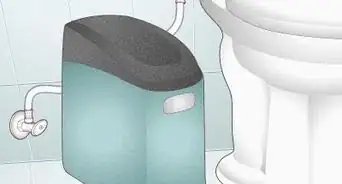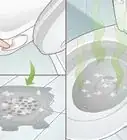This article was co-authored by Eric Shipe. Eric Shipe is a Kitchen and Bath Designer and the Owner of Bath + Kitchen based in Washington DC. Eric and his team specialize in cabinetry, design, and remodels. They serve homeowners, interior designers, architects, and contractors with a refined process, creative ideas, 4K photo-realistic renderings, and 360 Panoramic views. Bath + Kitchen was featured in Best of Houzz 2017-2020. Eric holds a BA in Economics and Business Administration from Ursinus College.
There are 11 references cited in this article, which can be found at the bottom of the page.
wikiHow marks an article as reader-approved once it receives enough positive feedback. In this case, 100% of readers who voted found the article helpful, earning it our reader-approved status.
This article has been viewed 105,464 times.
In your lifetime, you're going to flush your toilet an average of 140,000 times. Your toilet will also account for about 30% of your home's water use, so replacing an old, faulty toilet or purchasing an eco friendly toilet can benefit both the environment and your bottom line. While most people are familiar with the standard gravity toilet with a tank on the back, details like flushing power, water conservation, and a model's design should all be considered before you purchase a toilet.
Steps
Considering the Different Types of Toilets Available
-
1Understand the mechanics behind a toilet. When you flush a standard toilet, the handle pulls up a chain, which raises a flush valve. This flush valve then releases at least two gallons (about 7.5 litres) of water from the tank into the bowl in about three seconds, which triggers the siphon to suck the contents of the bowl down the drain and into a sewer system or septic tank. However, contrary to popular belief, the tank is not the most important part of a toilet's technology. In fact, you could detach the tank from the toilet and pour two gallons of water into the bucket by hand, and the toilet would still flush.
-
2Consider a gravity-assisted toilet. This type is the most common type in North America. These toilets use the weight and height of the water in the tank to facilitate a flush. The tank then refills via a small gushing pipe (usually plastic) until a float shuts off the flow. If any water does happen to flow a little higher from gushing, hand-motion inside, or even an earthquake, a narrow overflow tube handles any overflow problems. So, as long as the toilet is functioning properly, no water should spill outside of the porcelain tank. This type is the staple toilet, simple, effective, and durable. The flushing sound for gravity assisted toilets also isn't particularly loud and they are easy to repair. However, if you have a lot of people using your toilet (say, a large family) or are going to be putting a lot of wear on the toilet's flush system, gravity-assisted toilets may not have enough power to flush consistently, after every use.
- Think about purchasing a standard gravity-assisted toilet if you have a small family or a bathroom that will be getting minimal use.
Advertisement -
3Consider a pressure-assisted toilet. Unlike gravity assisted, pressure-assisted toilets have an ‘active’ rather than a passive mechanism. This type adds pressure to the force of gravity by supplying more force than the traditional unit. Water displaces air inside a sealed cylindrical tank, usually made of metal or plastic, inside the larger ceramic tank, helping to generate a larger force. However, because the water in the tank is held under pressure, it flushes with greater force, resulting in a loud flushing sound. As well, a greater amount of pressure via your toilet can put stress on older pipes and plumbing in your home, which can lead to a leak or a busted pipe.
- Go for a pressure-assisted toilet if you live in a newer building or a home with new, well kept pipes, and low water pressure.
-
4Consider a vacuum-assisted toilet. This type innovates on the standard gravity-assisted toilet by using a vacuum that draws the water with more force into the bowl using the rim holes in the upper toilet bowl. Vacuum-assisted toilets have a cleaner, quieter flush than other models, making them ideal for a bathroom near your bedroom, or by a quiet area of your home. However, unclogging this type of toilet requires some time and skill. To unplug the bowl, you have to take the lid off and put your hand over an opening in the tank for the plunging action to work. The vacuum-assisted toilet also costs about $100 more than a gravity toilet.
- Think about getting this type if you're looking for a toilet with quiet but powerful flushing, and are willing to spend some extra money up front.
-
5Consider a power-assisted toilet. This type uses an even greater force than vacuum-assisted toilets. In fact, power-assisted toilets are known as the only "toilets with horsepower".[1] These toilets have a 0.2 horsepower motor in the tank to literally blast waste products down the drain, making them ideal if your bathroom has old pipes. Power-assisted toilets can also save the average family 2,000 gallons of water per year. However, these toilets have a pump that must be plugged into a power outlet, they are known for their incredibly loud flushing sound and they are currently the most expensive type of toilet on the market.[2]
- Think about purchasing a power-assisted toilet if you're in need of a model with a super powerful flush, regardless of upkeep or cost.
-
6Consider a dual flush toilet. These toilets have two buttons on the tank, one for a half tank flush, the other for a full tank flush (obviously, you utilize either flush based on your needs). Originally invented in Australia to respond to the country's constant drought cycle, dual flush toilets are just starting to gain popularity in North America, and have the best water conservation system of any other models. In fact, studies have shown that a dual-flush toilet uses an average of just 6.9 gallons per day, compared to 9.5 gallons of a low-flow toilet and 19 gallons with the older models. This type can save a household 2,250 gallons of water per a year, and because there are two flushing options, you have the choice between a lighter sounding flush and a louder sounding flush.[3] However, this type has a high up front price tag, and high installation costs.
- Go for a dual flush toilet if you're looking for an eco friendly, option friendly toilet. Keep in mind that the long term benefits of a dual flush toilet in terms of water savings may be worth the initial cost.
Finding the Right Flushing System
-
1Determine the toilet's flushing power. Finding a toilet that flushes effectively without clogging is essential. But, a toilet with less water usage does not always mean it has less flushing power than another model.[4] The ideal toilet would have great waste removal and high clog resistance.
- To learn about the flushing performance of a specific toilet, use the Maximum Performance (MaP) Test at the Alliance For Water Efficiency website.
- Most major hardware and houseware stores label their selection of toilets with a numerical score based on their flush performance, taking into account waste removal power and clog resistance.[5]
-
2Check out the toilet's gallons used per flush. Current toilet models use 1.6 gallons per flush (GPF), which is about half the amount of water used by older toilets.
- Toilets with a Water Sense label use just 1.28 GPF and received approval as a high-efficiency toilet (HET) from the Environmental Protection Agency (EPA). More information about the WaterSense Program is available at the EPA's website.[6]
Determining the Best Model for Your Bathroom
-
1Compare one-piece and two-piece models[7] . Your preference for each model may depend on the set up of your bathroom, and your preferred aesthetic or design.
- One-piece models are designed so the tank and the bowl are integrated into a compact unit, making them easy to clean and ideal for smaller bathrooms where you need to save space. However, these models can be more expensive than the standard two-piece model.
- Two-piece toilet models are the more traditional design of a separate bowl and tank. They are more affordable than one-piece models, and are cheaper to install. However, they take up more space and are more difficult to clean.
- You might also prefer a tankless system.[8]
-
2Evaluate the shape of the toilet seat. Most toilet seats are available in two shapes: elongated and round. Elongated seats are more comfortable, as their shape adds room and comfort, especially for adult. Round seats are about 2 inches (5.1 cm) shorter, which may work better in cramped bathrooms or with smaller individuals and young children.[9]
-
3Choose a toilet height that's easy to use. Small children will be comfortable with the standard height of 14–15 inches (35.6–38.1 cm). The Comfort Height toilet models are 17 to 19 inches (43.2 to 48.3 cm) off the floor and 2 to 4 inches (5.1 to 10.2 cm) taller than regular-height toilets[10] . Comfort Height toilets meet the standards of the Americans with Disabilities Act (ADA), making them ideal for seniors and those with a disability.
-
4Always buy a toilet with the correct rough-in. This is the distance between the outlet pipe for the toilet and the wall behind the toilet. Toilet models are available in various sizes to fit different rough-ins, so choosing the right size is crucial.[11]
- To determine the size of your toilet rough-in, measure from the wall behind the toilet to the bolt caps of your current toilet. Do not include baseboards in your measurements.[12]
- Most toilets are available in a 12-inch rough-in, which is the standard distance, but a 10- or 14-inch rough-in may be needed in some homes.
-
5Consider any other preferences before you purchase. For example, a toilet with an antimicrobial glaze finish will inhibit the growth of bacteria inside the bowl. And if you can't stand the clanking sound when a standard toilet seat is put down, a self-closing toilet seat[13] may be a good option. Like anything, there is always the option of a fully custom toilet or a bidet. Keep in mind that a design choice like a unique toilet colors can make a statement in your bathroom, but they will cost more than a standard white model.[14]
- If a friend or loved one has a disability, consider buying a toilet that meets their needs.[15]
Expert Q&A
-
QuestionHow do you know if a toilet will fit?
 Eric ShipeEric Shipe is a Kitchen and Bath Designer and the Owner of Bath + Kitchen based in Washington DC. Eric and his team specialize in cabinetry, design, and remodels. They serve homeowners, interior designers, architects, and contractors with a refined process, creative ideas, 4K photo-realistic renderings, and 360 Panoramic views. Bath + Kitchen was featured in Best of Houzz 2017-2020. Eric holds a BA in Economics and Business Administration from Ursinus College.
Eric ShipeEric Shipe is a Kitchen and Bath Designer and the Owner of Bath + Kitchen based in Washington DC. Eric and his team specialize in cabinetry, design, and remodels. They serve homeowners, interior designers, architects, and contractors with a refined process, creative ideas, 4K photo-realistic renderings, and 360 Panoramic views. Bath + Kitchen was featured in Best of Houzz 2017-2020. Eric holds a BA in Economics and Business Administration from Ursinus College.
Home Improvement Specialist Always measure the rough-in! This is the construction stage where all the requisite mechanical, plumbing, and electrical lines are brought in, and it will dictate the size of toilet that can be installed.
Always measure the rough-in! This is the construction stage where all the requisite mechanical, plumbing, and electrical lines are brought in, and it will dictate the size of toilet that can be installed. -
QuestionWhat should I look for when buying a toilet?
 Eric ShipeEric Shipe is a Kitchen and Bath Designer and the Owner of Bath + Kitchen based in Washington DC. Eric and his team specialize in cabinetry, design, and remodels. They serve homeowners, interior designers, architects, and contractors with a refined process, creative ideas, 4K photo-realistic renderings, and 360 Panoramic views. Bath + Kitchen was featured in Best of Houzz 2017-2020. Eric holds a BA in Economics and Business Administration from Ursinus College.
Eric ShipeEric Shipe is a Kitchen and Bath Designer and the Owner of Bath + Kitchen based in Washington DC. Eric and his team specialize in cabinetry, design, and remodels. They serve homeowners, interior designers, architects, and contractors with a refined process, creative ideas, 4K photo-realistic renderings, and 360 Panoramic views. Bath + Kitchen was featured in Best of Houzz 2017-2020. Eric holds a BA in Economics and Business Administration from Ursinus College.
Home Improvement Specialist Think about whether you prefer a one piece, two-piece, or tankless system. Also, think about water efficiency, as there are many toilets available today that boast impressive water-saving capabilities.
Think about whether you prefer a one piece, two-piece, or tankless system. Also, think about water efficiency, as there are many toilets available today that boast impressive water-saving capabilities. -
QuestionHow do I choose a matching faucet?
 Community AnswerSome stores have toilets that match a faucet. If you found a toilet that you like and it doesn't have a matching faucet, you can either go for a silver or white one. You can also buy a bright colored one, if you want a contrast.
Community AnswerSome stores have toilets that match a faucet. If you found a toilet that you like and it doesn't have a matching faucet, you can either go for a silver or white one. You can also buy a bright colored one, if you want a contrast.
References
- ↑ http://homerenovations.about.com/od/toilets/ss/ToiletBuyersGuide_5.htm
- ↑ http://www.theplumber.com/fhb.html
- ↑ http://www.us.kohler.com/us/How-to-Shop-Bathroom-Products-How-to-Shop-for-Toilets/content/CNT800391.htm?locale=en_US&subSecId=CNT110400089
- ↑ http://www.consumerreports.org/cro/2012/03/toilet-tests-flush-out-the-best-models/index.htm
- ↑ http://www.homedepot.com/c/the_best_toilets_for_bath_renovation_HT_BG_BA
- ↑ http://www.epa.gov/watersense/
- ↑ http://www.us.kohler.com/us/How-to-Shop-for-Toilets/content/CNT800391.htm
- ↑ Eric Shipe. Home Improvement Specialist. Expert Interview. 12 July 2021.
- ↑ http://www.us.kohler.com/us/How-to-Shop-for-Toilets/content/CNT800391.htm
- ↑ http://www.consumerreports.org/cro/2012/03/toilet-tests-flush-out-the-best-models/index.htm
- ↑ Eric Shipe. Home Improvement Specialist. Expert Interview. 12 July 2021.
- ↑ http://www.us.kohler.com/us/How-to-Shop-for-Toilets/content/CNT800391.htm
- ↑ http://www.us.kohler.com/us/Toilet-Seats-Quiet-Close/category/972261/431473.htm
- ↑ Eric Shipe. Home Improvement Specialist. Expert Interview. 12 July 2021.
- ↑ Eric Shipe. Home Improvement Specialist. Expert Interview. 12 July 2021.
- Kitchen & Bath Planning Guide 2010 available at http://www.tauntonstore.com/kitchen-bath-planning-guide-027020.html
- http://www.epa.gov/watersense/products/toilets.html
About This Article
To buy a toilet, start by determining the rough-in, or the distance from the wall behind the toilet to the bolt caps of your current toilet so that you buy a model in the correct size. Then, decide between a traditional two-piece toilet, or a one-piece toilet, which is compact and easier to clean, but more expensive. Additionally, choose a high efficiency toilet (HET) with a WaterSense label if you want to save on your water bill. In general, an HET uses around 1.28 gallons of water per flush compared to older models that use about 1.6 gallons. For more advice, including how to choose between a gravity-assisted and pressure-assisted toilet, keep reading.
